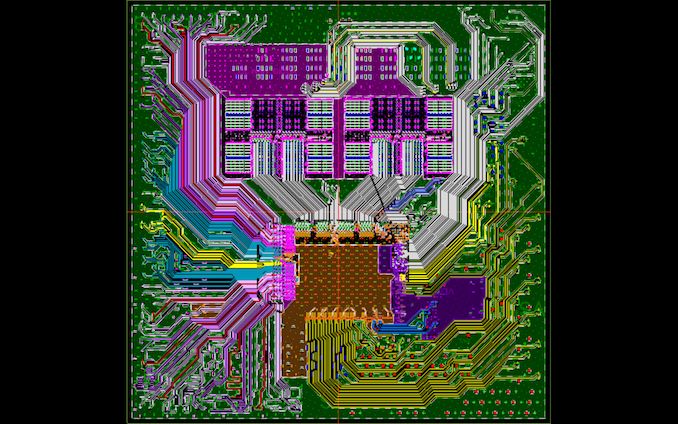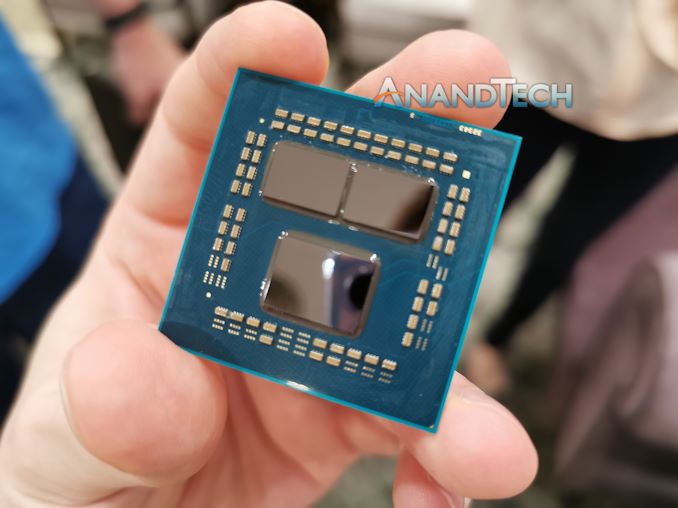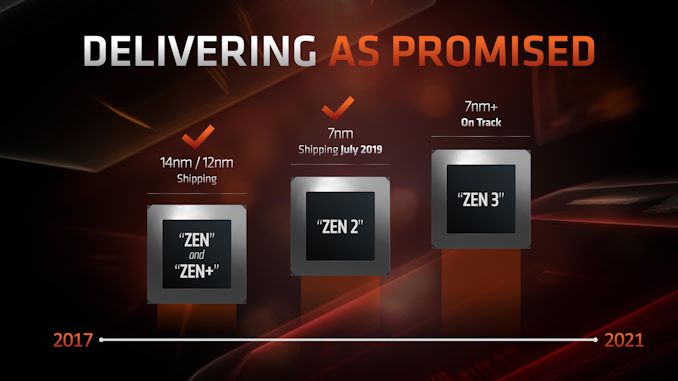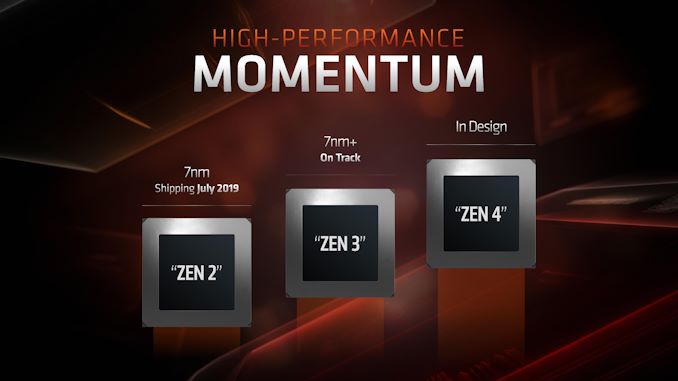AMD Zen 2 Microarchitecture Analysis: Ryzen 3000 and EPYC Rome
by Dr. Ian Cutress on June 10, 2019 7:22 PM EST- Posted in
- CPUs
- AMD
- Ryzen
- EPYC
- Infinity Fabric
- PCIe 4.0
- Zen 2
- Rome
- Ryzen 3000
- Ryzen 3rd Gen

Editor's Note: With Zen 2 set to launch tomorrow (7/7), here's our architecture analysis from last month for some timely background information.
We have been teased with AMD’s next generation processor products for over a year. The new chiplet design has been heralded as a significant breakthrough in driving performance and scalability, especially as it becomes increasingly difficult to create large silicon with high frequencies on smaller and smaller process nodes. AMD is expected to deploy its chiplet paradigm across its processor line, through Ryzen and EPYC, with those chiplets each having eight next-generation Zen 2 cores. Today AMD went into more detail about the Zen 2 core, providing justification for the +15% clock-for-clock performance increase over the previous generation that the company presented at Computex last week.
AMD’s Zen 2 Product Portfolio
The current products that AMD has announced that have Zen 2 cores include the Ryzen 3rd Generation consumer CPUs, known as the Ryzen 3000 family, and AMD’s next generation enterprise EPYC processor, known as Rome. As of today, AMD has announced explicit details of six consumer Ryzen 3000 processors, including core counts, frequencies, memory support, and power. Details about the server processor, aside from some peak values, are expected in due course over the next few months.
| AMD 'Matisse' Ryzen 3000 Series CPUs | |||||||||||
| AnandTech | Cores Threads |
Base Freq |
Boost Freq |
L2 Cache |
L3 Cache |
PCIe 4.0 |
DDR4 | TDP | Price (SEP) |
||
| Ryzen 9 | 3950X | 16C | 32T | 3.5 | 4.7 | 8 MB | 64 MB | 16+4+4 | 3200 | 105W | $749 |
| Ryzen 9 | 3900X | 12C | 24T | 3.8 | 4.6 | 6 MB | 64 MB | 16+4+4 | 3200 | 105W | $499 |
| Ryzen 7 | 3800X | 8C | 16T | 3.9 | 4.5 | 4 MB | 32 MB | 16+4+4 | 3200 | 105W | $399 |
| Ryzen 7 | 3700X | 8C | 16T | 3.6 | 4.4 | 4 MB | 32 MB | 16+4+4 | 3200 | 65W | $329 |
| Ryzen 5 | 3600X | 6C | 12T | 3.8 | 4.4 | 3 MB | 32 MB | 16+4+4 | 3200 | 95W | $249 |
| Ryzen 5 | 3600 | 6C | 12T | 3.6 | 4.2 | 3 MB | 32 MB | 16+4+4 | 3200 | 65W | $199 |
The Zen 2 design paradigm, compared to the first generation of Zen, has changed significantly. The new platform and core implementation is designed around small 8-core chiplets built on TSMC’s 7nm manufacturing process, and measure around 74-80 square millimeters. On these chiplets are two groups of four-cores arranged in a ‘core complex’, or CCX, which contains those four cores and a set of L3 cache – the L3 cache is doubled for Zen 2 over Zen 1.
Each full CPU, regardless of how many chiplets it has, is paired with a central IO die through Infinity Fabric links. The IO die acts as the central hub for all off-chip communications, as it houses all the PCIe lanes for the processor, as well as memory channels, and Infinity Fabric links to other chiplets or other CPUs. The IO die for the EPYC Rome processors is built on Global Foundries' 14nm process, however the consumer processor IO dies (which are smaller and contain fewer features) are built on the Global Foundries 12nm process.
The consumer processors, known as ‘Matisse’ or Ryzen 3rd Gen or Ryzen 3000-series, will be offered with up to two chiplets for sixteen cores. AMD is launching six versions of Matisse on July 7th, from six cores to sixteen cores. The six and eight-core processors have one chiplet, while above this the parts will have two chiplets, but in all cases the IO die is the same. This means that every Zen 2 based Ryzen 3000 processor will have access to 24 PCIe 4.0 lanes and dual channel memory. Based on the announcements today, the prices will range from $199 for the Ryzen 5 3600, up to $700+ for the sixteen core (we’re waiting on final confirmation of this price).
The EPYC Rome processors, built on these Zen 2 chiplets, will have up to eight of them, enabling a platform that can support up to 64 cores. As with the consumer processors, no chiplet can communicate directly with each other – each chiplet will only connect directly to the central IO die. That IO die houses links for eight memory channels, and up to 128 lanes of PCIe 4.0 connectivity.
AMD’s Roadmap
Before diving into the new product line, it is worth recapping where we currently sit in AMD’s planned roadmap.
In previous roadmaps, showcasing AMD’s movement from Zen to Zen 2 and Zen 3, the company has explained that this multi-year structure will showcase Zen in 2017, Zen 2 in 2019, and Zen 3 by 2021. The cadence isn’t exactly a year, as it has depended on AMD’s design and manufacturing abilities, as well as agreements with its partners in the foundries and the current market forces.
AMD has stated that its plan for Zen 2 was to always launch on 7nm, which ended up being TSMC’s 7nm (Global Foundries wasn’t going to be ready in time for 7nm, and ultimately pulled the plug). The next generation Zen 3 is expected to align with an updated 7nm process, and at this point AMD has not made any comment about a potential ‘Zen 2+’ design in the works, although at this point we do not expect to see one.
Beyond Zen 3, AMD has already stated that Zen 4 and Zen 5 are currently in various levels of their respective design stages, although the company has not committed to particular time frames or process node technologies. AMD has stated in the past that the paradigms of these platforms and processor designs are being set 3-5 years in advance, and the company states it has to make big bets every generation to ensure it can remain competitive.
For a small insight into Zen 4, in an interview with Forrest Norrod, SVP of AMD’s Enterprise, Embedded, and Semi-Custom group, at Computex, he exclusively revealed to AnandTech the code name of AMD’s Zen 4 EPYC processor: Genoa.
| AMD EPYC CPU Codenames | |||
| Gen | Year | Name | Cores |
| 1st | 2017 | Naples | 32 x Zen 1 |
| 2nd | 2019 | Rome | 64 x Zen 2 |
| 3rd | 2020 | Milan | ? x Zen 3 |
| 4th | ? | Genoa | ? x Zen 4 |
| 5th | ? | ? | ? x Zen 5 |
Forrest explained that the Zen 5 code name follows a similar pattern, but would not comment on the time frame for the Zen 4 product. Given that the Zen 3 design is expected mid-2020, that would put a Zen 4 product for late 2021/early 2022, if AMD follows its cadence. How this will play into AMD’s consumer roadmap plans is unclear at this point, and will depend on how AMD approaches its chiplet paradigm and any future adjustments to its packaging technology in order to enable further performance improvements.














216 Comments
View All Comments
wurizen - Friday, June 14, 2019 - link
flex^^^wurizen - Friday, June 14, 2019 - link
OMFG! I. Am. Not. Talking. About. Intel. Mesh.I. Am. Talking. About. Infinity. Fabric. High. Memory. Latency!
Now that I got that off my chest, let's proceed shall we...
OMFG!
L3 Cache? WTF!
Do you think you're so clever to talk about L3 cache to show off your knowledge as if to convince ppl here you know something? Nah, man!
WTF are you talking about L3 cache, dude? Come on, dude, get with the program.
The program is "Cross-CCX-High-Memory-Latency" with Infinity Fabric 1.0
And, games (BO3, BF1, BF4 from my testing) are what is affected by this high latency penalty in real-time. Imagine playing a game of BO3 while throughout the game, the game is "micro-pausing" "Micro-slow-motioning" repeatedly throughout the match? Yep, you got it, it makes it unplayeable.
In productive work like video editing, I would not see the high latency as an issue unless it affects "timeline editing" causing it to lag, as well.
I have heard some complain issues with it in audio editing with audio work. But I don't do that so I can't say.
As for "compute-intensive applications (y'know, real work)" --delatFx2
....
.....
......
You duh man, bruh! a real compute-intensive, man!
"This article mentions a Windows 10 patch to ensure that threads get assigned to the same CCX before going to the adjacent one." --deltaFx2
Uhhh... that won't fix it. Only AMD can fix it in Infinity Fabric 2.0 (Ryzen 2), if, indeed, AMD has fixed it. By making it faster! And/or, reducing that ~110ns latency to around 69ns.
Now, my question is, and you (deltaFx2) hasn't mentioned it in your wise-response to my comments is that SLIDE of "Raw Memory Performance" showing 69ns latency at 3200 Mhz RAM. Is that Raw memory performance Intra-CCX-Memory-Performance or Inter-core-Memory-Performance? Bada-boom, bish!
wurizen - Friday, June 14, 2019 - link
it's a problem ppl are having, if you search enough....Alistair - Wednesday, June 12, 2019 - link
those kinds of micro stutters are usually motherboard or most likely your windows installation causing it, reinstall windows, then try a different motherboard maybewurizen - Wednesday, June 12, 2019 - link
Wow, really? Re-install windows?I just wanna know (cough, cough Anand) what the Cross-CCX-Latency is for Ryzen 2 and Infinity Fabric 2.0.
If, it is still ~110ns like before.... well, guess what? 110 nano-effin-seconds is not fast enough. It's too HIGH a latency!
You can't update bios/motherboard or re-install windows, or get 6000 Mhz RAM (the price for that, tjo?) to fix it. (As shown in the graph for whatever "Raw Memory Latency" is for that 3200 Mhz RAM to 3600 Mhz stays at 69 ns and only at 37333 Mhz RAM does it drop to 67ns?).... This is the same result PCPER did with Ryzen IF 1.0 showing that getting Faster RAM at 3200 Mhz did not improve the Cross-CCX-Memory-Latency....
supdawgwtfd - Thursday, June 13, 2019 - link
O don't get any stutters with my 1600.As above. It's nothing to do with the CPU directly.
Something else is causing the problem.
deltaFx2 - Thursday, June 13, 2019 - link
How so you know for sure that the microstutter or whatever it is you think you are facing is due to the inter-ccx latency? Did you actually pin threads to CCXs to confirm this theory? Do you know when inter-ccx latency even comes into play? Inter-ccx latency ONLY matters for shared memory being modified by different threads; this should be a tiny fraction of your execution time, otherwise you are not much better going multithreaded. Moreover, Each CCX runs 8 threads so are you saying your game uses more than 8? That would be an interesting game indeed, given that intel's mainstream gaming CPUs don't have a problem on 4c8t.To me, you've just jumped the the gun and gone from "I have got some microstutter issues" to "I know PCPer ran some microbenchmark to find out the latency" to "that must be the problem". It does not follow.
FreckledTrout - Thursday, June 13, 2019 - link
I agree. If micro stutter from CCX latency was really occurring this would be a huge issue. These issues really have to be something unrelated.wurizen - Friday, June 14, 2019 - link
Another thing that was weird was GPU usage drop from 98% to like 0% in-game, midst-action, while I was playing... constantly, in a repeated pattern throughout the game... this is not a server or games hitching. we understand as gamers that a game will "hitch" once in a while. this is like "slow-motion" "micro-pause" thing happening through out the game. happens in single player (BF1) so I ruled out server-side. It's like the game goes in "slow-motion" for a second... not once or twice in a match, per se. But, throughout and in a repeated constant fashion... along with seeing GPU usage to accompany the effect dropping from 98% or so (normal) to 0% for split seconds (again, not once or twice in a match; but a constant, repeated pattern throughout the match)And, there are people having head-scratching issues similar to me with Ryzen CPU.
No one (cough, cough Anand; nor youtube tech tubers will address it) seems to address it tho.
But, I think that Ryzen 2 is coming out and if Cross-CCX-High-LAtency-Issue is the same, then we're bound to hear more. I'm sure.
I am thinking tech sites are giving AMD a chance... but not sure... doesn't matter tho. I got a 7700k (I wanted the 8-core thing when 1700x Ryzen came out) but its fine. Im not a fanboy. Just a techboy.... if anything...
wurizen - Friday, June 14, 2019 - link
The "micro-stutter" or "micro-pausing" is not once or twice (I get those with Intel, as well) but, a repeated, constant pattern throughout the match and round of game. The "micro-stutter" and "micro-pause" also "FEELS" different than what I felt with my prior 3700K CPU and current 7700K CPU. It's like a "micro-slow-motion." I am not making this up. I am not crazy!